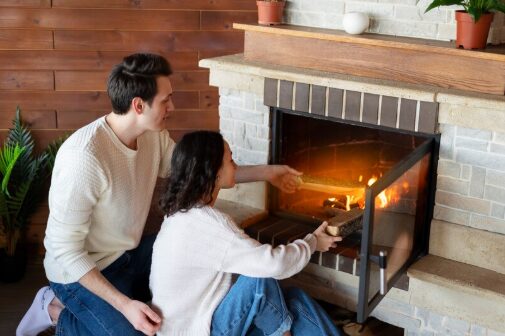A fireplace is more than just a source of heat – it’s an essential design element that can bring warmth, comfort, and charm to any home. Whether you’re replacing an old unit or installing a fireplace in a new space, choosing the right type for your needs is crucial. With various options available, such as gas, electric, and wood-burning fireplaces, making the right decision can feel overwhelming. This guide will help you understand the different types of fireplaces, their pros and cons, and how to choose the best one for your home.
Types of Fireplaces and How to Choose the Best One for Your Home
When deciding on a fireplace for your home, you need to consider several factors, such as efficiency, installation requirements, and maintenance. Fireplace stores offer a variety of options to suit different preferences and lifestyles.
What Factors to Consider When Buying a Fireplace
Choosing the right fireplace involves more than just picking a style you like. Consider these factors when making your decision:
- Space and Location: Measure the area where the fireplace will go. A large, traditional wood-burning fireplace may not be practical in a small room.
- Fuel Type: Decide whether you prefer a gas, electric, or wood-burning fireplace. Each fuel type has its benefits and drawbacks.
- Efficiency: If you want to heat a large space, consider gas fireplaces or wood-burning stoves for higher efficiency. Electric fireplaces are often used for ambiance but can still provide some warmth.
- Installation Requirements: Some fireplaces, like wood-burning stoves, require a chimney, while electric fireplaces are much easier to install since they don’t need venting.
How to Select the Best Fireplace for Your Living Space
Once you’ve considered the basics, think about your home’s design and the aesthetic you want. A modern electric fireplace could be perfect for a minimalist space, while a traditional wood-burning fireplace could complement a cozy, rustic living room. When choosing the right fireplace, also think about:
- Design Style: Whether you’re going for a modern, traditional, or rustic feel, the fireplace should blend seamlessly with your existing decor.
- Heating Capacity: If you want your fireplace to provide significant heat, make sure it’s powerful enough to warm the room or even larger areas of your home.
- Maintenance: Some fireplaces require more upkeep than others. For example, wood-burning fireplaces need regular cleaning, while electric fireplaces are nearly maintenance-free.
Gas Fireplaces vs. Electric Fireplaces: Which One Fits Your Home Best?
There are distinct differences between gas fireplaces and electric fireplaces, and each one comes with its own set of benefits.
Electric Fireplaces: Easy Installation and Maintenance
Electric fireplaces are a popular choice for homeowners looking for a low-maintenance, easy-to-install option. They don’t require a vent or chimney, which makes them a convenient choice for any room. Additionally:
- Safety: Electric fireplaces are very safe since they don’t involve actual flames or combustion.
- Convenience: They’re typically easier to install and operate, and many models come with remote controls for adjusting heat and flame settings.
- Ambiance: While they don’t provide as much heat as gas or wood-burning fireplaces, they can still create a cozy atmosphere with their realistic flame effects.
Gas Fireplaces: Benefits of Realistic Flames and Efficient Heating
On the other hand, gas fireplaces offer a more traditional fireplace experience with real flames and more substantial heat output. Here’s why you might consider a gas fireplace:
- Realistic Flames: Gas fireplaces use natural gas or propane to create flames that look and feel more like a traditional wood-burning fire.
- Heating Power: Gas fireplaces are more powerful than electric models, making them better for heating larger rooms or even multiple rooms.
- Efficiency: They are more energy-efficient than wood-burning fireplaces and are easy to control, allowing for more consistent heat.
How to Maintain Your Fireplace for Safety and Efficiency
Whether you choose a gas or electric fireplace, proper maintenance is essential to ensure that it operates safely and efficiently.
The Importance of Regular Fireplace Cleaning
Regular cleaning is vital for any fireplace, especially wood-burning and gas models. Here’s why cleaning matters:
- Gas Fireplaces: Even though gas fireplaces don’t require as much upkeep as wood-burning units, the burners, logs, and glass should be cleaned regularly to ensure proper airflow and efficiency.
- Wood-Burning Fireplaces: Wood-burning fireplaces require more frequent cleaning. The chimney and flue should be cleaned at least once a year to prevent the buildup of creosote, which is a flammable substance.
How to Prevent Common Fireplace Problems
- Check for Gas Leaks: For gas fireplaces, ensure that the gas line and connections are secure. If you notice a smell of gas, turn off the fireplace and contact a professional immediately.
- Inspect for Cracks: Always check for cracks in the glass or any other components of the fireplace. These can reduce the efficiency and safety of your fireplace.
Fireplace Accessories You Shouldn’t Miss
No fireplace setup is complete without the right accessories. Accessories not only improve the look of your fireplace but also enhance its functionality.
Best Accessories for Fireplace Safety and Style
- Fireplace Screens: A screen can protect your home from sparks and ash, especially in wood-burning fireplaces.
- Log Holders: For wood-burning fireplaces, a stylish log holder can keep firewood organized and easily accessible.
- Fireplace Tools: A set of essential tools such as a poker, shovel, and broom is needed for handling the fire and cleaning up afterward.
The Must-Have Fireplace Tools Every Home Should Have
Even if you don’t have a traditional wood-burning fireplace, there are some useful tools for gas and electric models:
- Thermostat Controls: For gas and electric fireplaces, having a thermostat or remote control allows you to adjust the temperature and maintain comfort.
- Glass Cleaner: Keeping your fireplace glass clean is key to maintaining the aesthetic and efficiency of the unit.
Energy-Efficient Fireplaces for Sustainable Living
If you’re looking for an eco-friendly option, there are several energy-efficient fireplaces to consider. These options provide warmth while reducing your carbon footprint.
The Environmental Benefits of Modern Fireplaces
Modern gas and electric fireplaces use advanced technology to reduce energy waste. For example:
- Gas fireplaces are more efficient than wood-burning stoves, producing less pollution and using natural gas, which is often cleaner than coal.
- Electric fireplaces don’t require burning fuel, making them one of the most environmentally friendly options, especially when powered by renewable energy sources.
How to Choose an Energy-Efficient Fireplace for Your Home
When shopping for an energy-efficient fireplace, look for models that are certified for energy efficiency. For example, the EPA (Environmental Protection Agency) offers certifications for wood stoves that meet strict emission standards.
Conclusion: Finding the Right Fireplace for Your Home
Choosing the right fireplace for your home can be a challenging yet exciting process. Whether you opt for an electric fireplace, gas fireplace, or a wood-burning model, it’s important to select one that fits your home’s needs and your family’s lifestyle. By considering the space, fuel type, efficiency, and design, you can create a cozy, efficient, and safe environment for your home.
Remember, regular maintenance and the right accessories will help keep your fireplace working efficiently and safely for years to come. No matter which option you choose, a fireplace will be an excellent investment that adds warmth, style, and comfort to your home.







